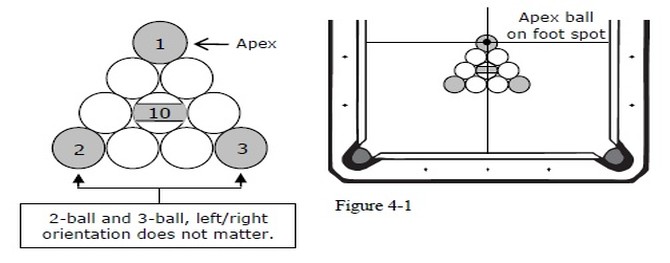Ligue de Billard de Montreal
Main menu
- Accueil
- League Info
- Emplacements
- Photos/Videos
- Documents
- Links
- Contactez Nous
- Referree Zone
10 Ball Rules
4-
10-
4-
The balls are racked as follows (see Figure 4-
a. in a triangle shape with the 1-
b. the rows behind the apex are parallel to the foot string;
c. the 10-
d. the 2-
e. the remaining balls are placed at random.
4-
1. You begin the break with ball in hand behind the head string. The break is not a called shot, and you may not call a ball on the break. The cue ball must contact the 1-
2. If you legally pocket a ball, you continue to shoot. Your inning ends if you do not legally pocket a ball or if you foul.
3. If you legally pocket the 10-
4. Jumped object balls other than the 10-
4-
1. If there was no foul on the break, the player taking the first shot after the break has the option to shoot a push-
a. you must notify your opponent before the shot and your opponent must acknowledge your intention;
b. the cue ball is not required to contact the lowest numbered ball first, or any object ball at all;
c. no ball is required to contact a cushion
d. all other rules and fouls still apply.
2. Any object balls except the 10-
3. After a push-
c. accept the table in position and shoot;
d. require you to shoot again with the table in position.
If you push-
4-
1. After the break (and push-
a. you must contact the lowest numbered ball on the table first or it is a foul;
b. the 10-
c. other jumped object balls and illegally pocketed balls are not spotted.
2. When it is your inning, you continue to shoot as long as you legally pocket a called ball on each shot. If the called ball is legally pocketed, object balls, other than the 10-
3. The game is won by the player who legally pockets the 10-
4-
4-
1. A ball is illegally pocketed if it is:
a. the called ball and is pocketed in other than the called pocket;
b. not the called ball and is pocketed on a shot in which the called ball is not legally pocketed;
2. If the 10-
4-
If you illegally pocket any ball, your opponent has the option to:
a. accept the table in position, or;
b. require you to shoot again.
4-
You lose the game if you commit three successive fouls in one game.
4-
If a referee judges that the game is not progressing because the position of the table has not significantly changed through three consecutive innings by each player, the referee will declare a stalemate and the game will be replayed with the player who broke the game breaking again. (AR p. 104)